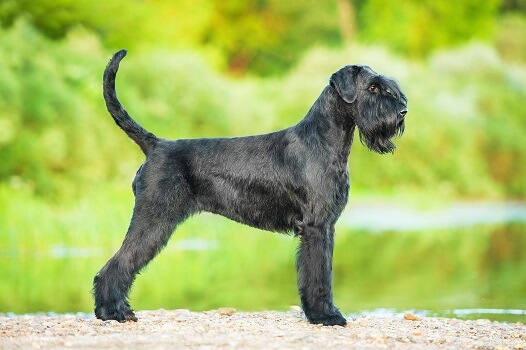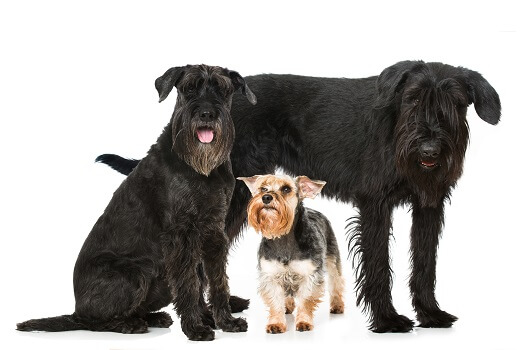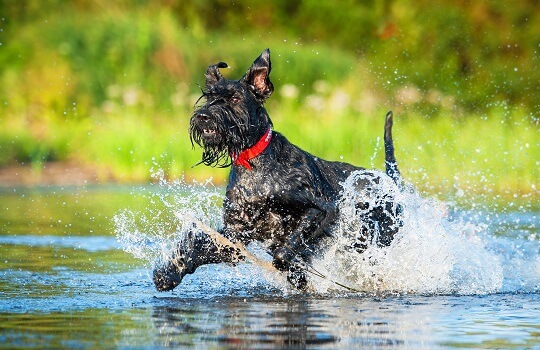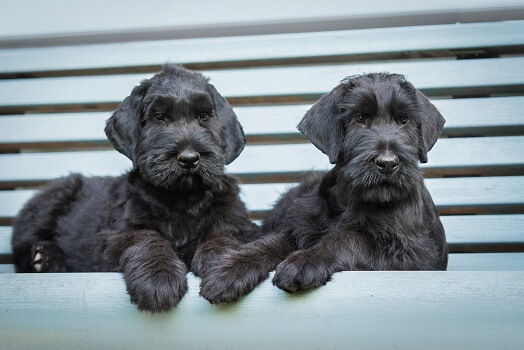
The Giant Schnauzer originated in Germany and is the largest of the three schnauzer breeds. This breed is the most recent of the schnauzer breeds and was developed by Bavarian cattlemen who wanted to produce a dog that was, like the Standard Schnauzer, good at herding cattle, but was larger in size. The Giant Schnauzer was bred from the Standard Schnauzer crossed with a variety of larger dogs, which people believe included the Great Dane. The Giant Schnauzer is a powerful and robust dog that is square in shape. Its head is strong and rectangular in appearance and they have dark, oval-shaped eyes. These dogs have a double-coat that is wiry and it is either all black, salt-and-pepper, or black-and-tan in color. Giant schnauzers have bushy eyebrows, whiskers, and a beard that is made up of longer, coarser hair. These dogs require regular grooming to keep their coat clean. To retain their hallmark look, they will require regular trips to the groomers to keep head and body fur in check. This breed is an intelligent, working dog that is easy to train. Giant schnauzers require a lot of exercise. These dogs tend to be on the dominant side and require a firm owner who can be consistent and understand how dogs behave. These dogs make good guard and watchdogs and have a loud, intimidating bark. Giant schnauzers have found work in other areas, besides being a cattle dog. Their intelligence and temperament make them great working dogs and they have been used by the military and the police, as well as in search and rescue teams. Owing to their dominant, working nature and high prey drive these dogs do not do well with other dogs or small pets in the house. The Giant Schnauzer is a large breed that was developed in Germany as a working dog. This dog has many good qualities but is very demanding and requires someone who knows how to handle them. Let’s take a closer look at this loveable giant! There are three Schnauzer breeds; the Standard Schnauzer, Miniature Schnauzer, and the Giant Schnauzer. The Standard Schnauzer is the original breed and the other two breeds were bred by breeding the Standard Schnauzer with other dogs. The exact date that the Giant Schnauzer came into being in not known, but the Standard Schnauzer appears in artwork that dates back to 1492 and we know that the Giant Schnauzer was developed after that. The Giant Schnauzer was bred by cross-breeding the Standard Schnauzer with larger dogs including the Great Dane and the Bouvier des Flandres. The Giant Schnauzer was bred to be a herd and guard livestock. It was used to drive cattle to market and to pull cards. By the beginning of the 20th century, the Giant Schnauzers role had changed and it was being used to guard breweries, stockyards, and butcher shops. While dogs have evolved away from their closest relatives, the wolf, most of the breeds have retained their desire and ability to hunt. As different breeds have been bred for different characteristics, the drive to hunt is different depending on the breed. Prey drive involves five different behaviors: searching, stalking, chasing, biting to grab, and biting to kill, and these behaviors can be different in different breeds so it is important to understand how different breeds may behave around other animals. Giant Schnauzers were bred to drive cattle and be a guarding dog which means they are more likely to chase and try to catch another animal. They need to be kept on a leash or a well-fenced in yard. Giant Schnauzers are a deep-chested breed that is prone to bloating, which is caused by the stomach expanding with air. Sometimes this can lead to a more serious condition called gastric torsion or gastric dilatation-volvulus. This condition can be life-threatening if it is not treated immediately. When the stomach fills with air it causes pressure to build which prevents blood from the hind legs and the abdomen from returning to the heart. Blood builds up at the back of the body which reduces the working blood volume and sends the dog into shock. This condition can become worse if the stomach then twists on itself, further cutting off blood flow. The dog must receive immediate veterinary attention which will involve surgery to correct the problem. Symptoms of this condition involve restlessness, pacing, drooling, pale gums and lip licking, signs of pain, and an inability to vomit. If a dog is diagnosed with this condition then it is possible to operate on the dog to prevent the stomach from twisting again. This procedure is known as ‘stomach tacking’.
Kingdom
Animalia
Phylum
Chordata
Class
Mammalia
Order
Carnivora
Family
Canidae
Genus
Canis
Species
Canis lupus
Subspecies
Canis lupus familiaris
Height
23 – 27 inches (58.4 – 68.6 cm)
Weight
65 – 90 lbs (29.5 – 40.8 kg)
Lifespan
10 – 12 years
Social Structure
Domesticated, working dog
Status
Least concern
Natural Habitat
Domesticated
Average Litter Size
5 – 10 puppies
Main food item
Dog food
Potential predators
Few predators
The Basics

Fun Facts about the Giant Schnauzer!
One of Three Schnauzer Breeds

High Prey Drive

Prone to Bloat
